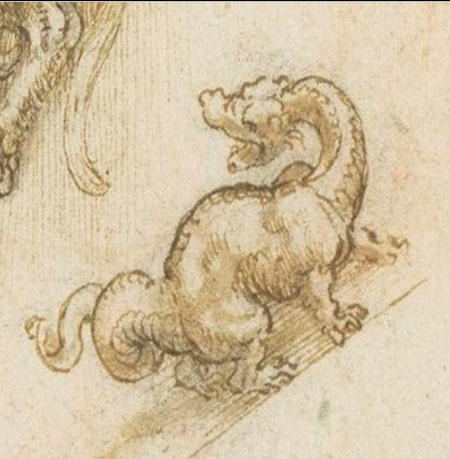Leonardo’s dragon

The month of May 2019 marks the 500th anniversary of the death of Leonardo Da Vinci (15 April 1452 – 2 May 1519). The polymath was well known for his contributions to science, history, engineering, architecture, drawing and especially painting, with his most famous painting being the Mona Lisa. For this anniversary the UK’s Royal Collection Trust is displaying some of its collection of Leonardo drawings in 12 different locations. One particular drawing is causing a stir.
Entitled ‘Cats, lions, and a dragon, drawn circa 1517–18’, you may begin to guess what the fuss is about. The pen and ink picture vividly shows cats and lions in various lifelike poses. The note at the bottom of the drawing reads, “Of flexion and extension. This animal species, of which the lion is the prince because of its spinal column which is flexible.” It suggests that the drawing is concerned with the range of movements achievable by cats. Some have linked it to a note by Leonardo indicating that it may have been used in a larger study on animals that walk on all four feet.1 Leonardo would have been able to observe ordinary cats easily, and, “Lions were well enough known in Italy at the time—they were, for example, kept in a cage behind the Palazzo della Signoria in Florence, as one of the symbols of the city.”2 Leonardo even built a moving robot lion around the same time to entertain King Francis I of France.3 It could sit and present flowers from its chest.

Direct observations
Descriptions of the cat and lion drawings all come to the same conclusion—that they were drawn from direct observations. However, when it comes to the dragon in the picture, the Royal Collection Trust states, “the dragon was added simply as a still more extreme case (as limited only by the artist’s imagination rather than by real anatomy).” But why must this be the case? Surely this is a pure assumption, and a huge one at that. It appears to be based solely upon an evolutionary understanding of history which alleges dinosaurs (dragons) died out 65 million years ago, never living with mankind. It would make much more sense to be consistent and also attribute the dragon drawing to direct observation, rather than the drawing of an imaginary animal amongst real ones. Also, without Leonardo literally looking at the ‘dragon’ how would he be able to draw an extinct animal so accurately?
A real ‘dragon’?
The word dinosaur was coined by Sir Richard Owen in 1841. Before this the word ‘dragon’ covered a large range of animals whose descriptions often very closely match dinosaurs and other extinct reptiles. If this is the case, does Leonardo’s dragon drawing match any of the known dinosaurs today? Expert dino-artefact researcher Vance Nelson4 says of it:
This was a typical depiction in Europe, of what used to be classified as ‘prosauropods’. They are now classified in various groups within a larger group, the basal sauropodomorphs. Though the head has the typical stylization of the 16th century, the morphology nevertheless makes it easy to identify within this group.
What’s interesting about dinosaurs that fall within this group, such as the Lessemsauridae, is that their front and rear legs had a distinctive bend as opposed to straight up-and-down columnar limbs. They also had five claws, just as depicted by Leonardo (see rear right foot). Could such particular detail be fabricated solely from the mind?
What about that tail?
Leonardo’s rendering of the dragon with a coiled tail is not uncommon throughout history, and it may have been an artistic device. However, noting that the first portion of the tail attached to the body is relatively stiff, just like other sauropod dinosaurs, there are other options. It may be that some dinosaurs had a prehensile (grasping) tail, such as some lizards today, easily able to make the same shape as in his drawing. The dinosaur is also notably in what looks like a defensive posture, so the tail could have been drawn capturing it ‘mid-whip’.5 The ability to coil a tail would be handy, such as when sleeping, moving in tight spaces, or even drawing it in defensively. We can no longer observe dinosaurs today, so there is some degree of speculation on the full range of movement of sauropodomorph tails.

Lessons for today
Leonardo’s dragon shows that modern evolutionary assumptions about the past can be quite wrong. It adds to the large body of drawings and depictions of dinosaurs since they exited Noah’s Ark some 4,500 years ago. While they may be extinct today their contemporary existence with humans is well testified to.
References and notes
- Leonardo da Vinci, Paris Manuscript E, XIV, Anatomy, Zoology and Physiology, 825, c. 1513–14. Return to text.
- Royal Collection Trust., Cats, lions, and a dragon c. 1517–18, rct.uk. Return to text.
- Di Angelo, P., Leonardo’s mechanical lion, gingkoedizioni.it, 16 February 2017. Return to text.
- Bates, G., Unearthing exciting evidence for creation: Gary Bates interviews fossil researcher Vance Nelson, Creation 41(2), 12–15, 2019. Return to text.
- Geggel, L., Dinosaur’s tail whips could have cracked sound barrier, livescience.com, 21 October 2015; cf. Dinosaurs whipped mates into line? Return to text.







Readers’ comments
Comments are automatically closed 14 days after publication.